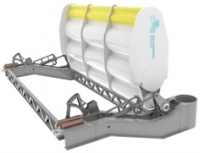Aquamarine Power has unveiled the latest design of its Oyster wave energy device which it claims can generate up to 250 per cent more energy than its previous model.
The 800kW Oyster 2 model follows Oyster 1 which was successfully deployed at the European Marine Energy Centre (EMEC) in Orkney last summer. The new model measures 26m by 16m and is due to be built in Scotland later this year.
According to the Edinburgh-based company, while the overall design concept remains the same, each component on Oyster 2 has been improved to increase efficiency. In addition, all of the device’s hydraulic elements are now modular, so they can be changed more easily during maintenance and installation.
The most obvious change is the geometry of the machine. ‘It’s actually a very different shape,’ said Martin McAdam, chief executive of Aquamarine Power. ‘The flap now has these rounded ends on it. It is also about 50 per cent bigger in terms of material usage, but it actually delivers about 250 per cent additional power output.’

Oyster is a buoyant, hinged flap device which is attached to the seabed at around ten metres depth. The hinged flap, which is almost entirely underwater, sways backwards and forwards in the nearshore waves. Two hydraulic pistons are driven by the movement of the flap which pushes high pressure onshore to drive a conventional hydro-electric turbine.
Earlier this year, Aquamarine Power received £5.1m of funding from the Carbon Trust’s Marine Renewables Proving Fund (MRPF) for the development of Oyster. The group hopes the funding, amongst other things, will help explore the possibility of using different materials for future designs.
‘At the moment, Oyster is made from steel,’ explained McAdam. ‘But we’re doing some materials studies where we’re looking at using either composites or composites and concrete or a combination of steel, composites and concrete. We’re even looking at things like engineered wood as a potential material for some of the construction.’
Plans to deploy three Oyster 2s at the European Marine Energy Centre (EMEC) in Orkney in summer 2011. All three devices will be linked to a single onshore 2.4MW hydro-electric turbine. The company estimates that a small farm of 20 Oyster 2 devices would be enough to power over 12,000 homes.




Project to investigate hybrid approach to titanium manufacturing
What is this a hybrid of? Superplastic forming tends to be performed slowly as otherwise the behaviour is the hot creep that typifies hot...